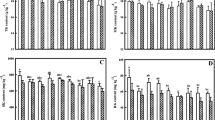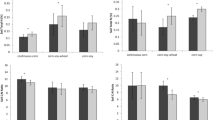Abstract
One-year simple NPK trials were conducted in 22 locations in four regions of Colombia to determine the response of cassava (Manihot esculenta Crantz) to N, P and K and to relate this response to the available P and K contents of the soil, as well as to the N, P, and K concentrations in youngest fully expanded leaf (YFEL) blades sampled at 3–5 months after planting. It was found that cassava responded mainly to P applications in the low-P soils of the Eastern Plains and of Cauca Department, to K applications only in the Eastern Plains and to N applications principally in the sandy, low-OM soils of the Atlantic Coast. By relating the relative response to P and K to the available P and exchangeable K content of the soil, respectively, critical levels of 4 mg P/kg and 0.17 me K/100 g (both extracted with Bray II) were determined. Similarly, critical levels of 5.6% N, 0.41% P and 1.42% K were determined in YFEL-blades.
A long-term fertilizer trial with 35 treatments was conducted for 8 consecutive years in the highly acid low-fertility soil at CIAT-Quilichao, to determine the effect of cassava production and fertilization on soil fertility. Although the first year response was mainly to P and N, already in the second year K became the most limiting nutrient and the importance of K fertilization increased over the years. This trial, and similar long-term fertility trials conducted in Colombia and in various parts of Asia, have all shown the importance of adequate annual applications of K for maintaining high yields of continuously grown cassava.
Similar content being viewed by others
References
Amarasiri SL and Perera WR (1975) Nutrient removal by crops growing in the dry zone of Sri Lanka. Tropical Agriculturist 131: 61–70
Asher CJ, Edwards DG and Howeler RH (1980) Nutritional Disorders of Cassava (Manihot esculenta Crantz). Univ of Queensland, St. Lucia, Q, Australia, 48 p
Cadavid LF (1988) Respuesta de la yuca (Manihot esculenta Crantz) a la aplicacion de NPK en suelos con diferentes caracteristicas. Trabajo Especial. Univ Nacional de Colombia, Palmira, Colombia, 185 p
Central Tuber Crops Research Institute (CTCRI) (1971) Annual Report for 1970. Trivandrum, India
Central Tuber Crops Research Institute (CTCRI) (1972) Annual Report for 1971. Trivandrum, India
Central Tuber Crops Research Institute (CTCRI) (1973) Annual Report for 1972. Trivandrum, India
Central Tuber Crops Research Institute (CTCRI) (1974) Annual Report for 1973. Trivandrum, India
Central Tuber Crops Research Institute (CTCRI) (1987) Annual Report for 1986. Trivandrum, India
Centro Internacional Agricultura Tropical (CIAT) (1975) Annual Report for 1974. Cali, Colombia
Centro Internacional Agricultura Tropical (CIAT) (1977) Annual Report for 1976. Cali, Colombia
Centro Internacional Agricultura Tropical (CIAT) (1978) Beef Program Annual Report for 1977. Cali, Colombia
Centro Internacional Agricultura Tropical (CIAT) (1980) Tropical Pastures Program Annual Report for 1979. Cali, Colombia, CIAT, Series #02 ETP 1–1979 pp 21–35
Centro Internacional Agricultura Tropical (CIAT) (1982) Cassava Program Annual Report for 1981. Cali, Colombia
Centro Internacional Agricultura Tropical (CIAT) (1985a) Cassava Program Annual Reports for 1982 and 1983. Cali, Colombia
Centro Internacional Agricultura Tropical (CIAT) (1985b) Cassava Program Annual Report for 1984. Working Document No. 1, 1985. CIAT, Cali, Colombia
Centro Internacional Agricultura Tropical (CIAT) (1988a) Cassava Program Annual Report for 1985. Working Document No. 38, 1988. CIAT, Cali, Colombia
Centro Internacional Agricultura Tropical (CIAT) (1988b) Cassava Program Annual Report for 1986. Working Document No. 43, 1988. CIAT, Cali, Colombia
Chan SK (1980) Long-term fertility considerations in cassava production.In: EJ Weber, JC Toro and M Graham (Eds.) Cassava Cultural Practices. Proc Workshop held in Salvador, Bahia, Brazil, March 18–21, 1980. IDRC 151e Ottawa, Canada, 82–92
Cock JH (1985) Cassava. A New Potential for a Neglected Crop. Westview Press Inc. Boulder, Colorado, 192 p
Cours G, Fritz J and Ramahadimby G (1961) El diagnostico felodermico de la mandioca. Fertilite 12: 3–20
Food and Agriculture Organization of the United Nations (FAO) (1980) Review of data on responses of tropical crops to fertilizers 1961–1977, 101 p
Food and Agriculture Organization (FAO) (1989) FAO Production Year Book 1988
Gomes J de C and Howeler RH (1980) Cassava production in low fertility soils.In: EJ Weber, JC Toro and M Graham (Eds.) Cassava Cultural Practices. Proc Workshop held in Salvador, Bahia, Brazil, March 18–21, 1980. IDRC 151e Ottawa, Canada, 93–102
Hagens P and Sittibusaya C (1990) Short and long-term aspects of fertilizer application on cassava in Thailand.In: R Howeler (Ed) Proc 8th Symp Int Soc Trop Root Crops, Bangkok, Thailand, Oct 30–Nov 5, 1988, 244–259.
Howeler RH (1980) Soil-related cultural practices for cassava.In: EJ Weber, JC Toro and M Graham (Eds.) Cassava Cultural Practices. Proc. Workshop held in Salvador, Bahia, Brazil, March 18–21, 1980. IDRC 151e Ottawa, Canada, 59–69
Howeler RH (1981) Mineral nutrition and fertilization of cassava. Series O9EC-4. Centro Internacional de Agric Tropical (CIAT), 52 p
Howeler RH (1985a) Mineral nutrition and fertilization of cassava.In. Cassava; Research, Production and Utilization. UNDP-CIAT Cassava Program, Cali, Colombia, 249–320
Howeler RH (1985b) Potassium nutrition of cassava.In. Potassium in Agriculture. ASA, CSSA, SSSA., Madison, Wisc, USA, 819–841
Howeler RH (1990a) Phosphorus requirements and management of tropical root and tuber crops.In. Proc Symp on Phosphorus Requirements for Sustainable Agriculture in Asia and Oceania. IRRI, Los Banos, Philippines, March 6–10, 1989 (in press)
Howeler RH (1990b) Long-term effect of cassava cultivation on soil productivity. Field Crops Research (in press)
Howeler RH, Sieverding E and Saif S (1987) Practical aspects of mycorrhizal technology in some tropical crops and pastures. Plant and Soil 100: 249–283
Instituto Geografico ‘Agustin Godazzi’ (IGAG) (1980) Estudio Semidetallado de Suelos del Valle Geografico del Rio Cauca. Bogota. 578 p
Jintakanon S, Edwards DG and Asher CJ (1982) An anomalous, high external phosphorus requirement for young cassava plants in solution culture.In: Proc 5th Int Symp Trop Root Crops. Manila, Philippines, Sept 17–21, 1979, 507–518
Jones US, Katyal JC, Mamaril CP and Park CS (1982) Wetland rice-nutrient deficiencies other than nitrogen.In. Rice Research Strategies for the Future. IRRI. Los Banos, Philippines, 327–378
Kabeerathumma S, Mohan Kumar B, Mohan Kumar CR, Nair GM, Prabhakar M and Pillai NG (1990) Long range effect of continuous cropping and manuring on cassava production and fertility status of soil.In R Howeler (Ed) Proc 8th Symp Int Soc Trop. Root Crops, Bangkok, Thailand, Oct 30– Nov 5, 1988, 259–269.
Nijholt JA (1935) Opname van voedingsstoffen uit den bodem bij cassave. (Absorption of nutrients from the soil by a cassava-crop). Buitenzorg. Algemeen Proefstation voor den Landbouw. Korte Mededeelingen No. 15
Novero WP and Ho CP (1985) Yield increase through the use of fertilizers and related inputs, Thailand; Fertilizer trials and demonstrations 1980–1984. FAO, Rome
Orlando Filho J (1985) Potassium nutrition of sugarcane.In: Potassium in Agriculture. ASA, CSSA, SSSA. Madison, Wisc, USA 1045–1062
Prevot P and Ollagnier M (1958) La fumure potassique dans les regions tropicales et subtropicales.In: Potassium Symposium, Berne, 277–318
Richards IR (1979) Response of tropical crops to fertilizer under farmers conditions — Analysis of results of the FAO Fertilizer Programme. Phosphorus in Agriculture 76: 147–156
Roberts S and McDole RE (1985) Potassium nutrition of potatoes.In: Potassium in Agriculture. ASA, CSSA, SSSA. Madison, Wisc, USA 799–818
Roche P, Velly J and Joliet B (1957) Essai de determination des seuils de carence en potasse dans le sol et dans les plantes. Revue de la Potasse, Febr 1–5, 1957
Rodriguez JM (1975) Fertilizacion de la yucaIn. Curso sobre produccion de yuca. Medellin, Instituto Colombiano Agropecuario Regional No. 4, Colombia
Spear SN, Edwards DG and Asher CJ (1978) Effects of nutrient supply on critical nutrient concentrations in cassava plants. Proc 8th Int Col Plant Analyses and Fertilizer Problems, Auckland, New Zealand, Aug 28–Sept 1, 1978
Tarazona C, Marin G and Leon A (1973) Respuesta de la yuca (Manihot esculenta Crantz) a la fertilizacion en parcelas demostrativas. Bogota, Instituto Colombiano Agropecuario, Colombia, 38 p
Waugh DL, Cate RB, Nelson LA and Manzano A (1974) New concepts of biological and economical interpretation of fertilizer response.In: E Bornemisza and A Alvarado (Eds.). Soil Management in Tropical America. Soil Sci Dept, North Carolina State Univ, Raleigh, NC, USA, 484–501
Author information
Authors and Affiliations
Rights and permissions
About this article
Cite this article
Howeler, R.H., Cadavid, L.F. Short-and long-term fertility trials in Colombia to determine the nutrient requirements of cassava. Fertilizer Research 26, 61–80 (1990). https://doi.org/10.1007/BF01048744
Issue Date:
DOI: https://doi.org/10.1007/BF01048744




